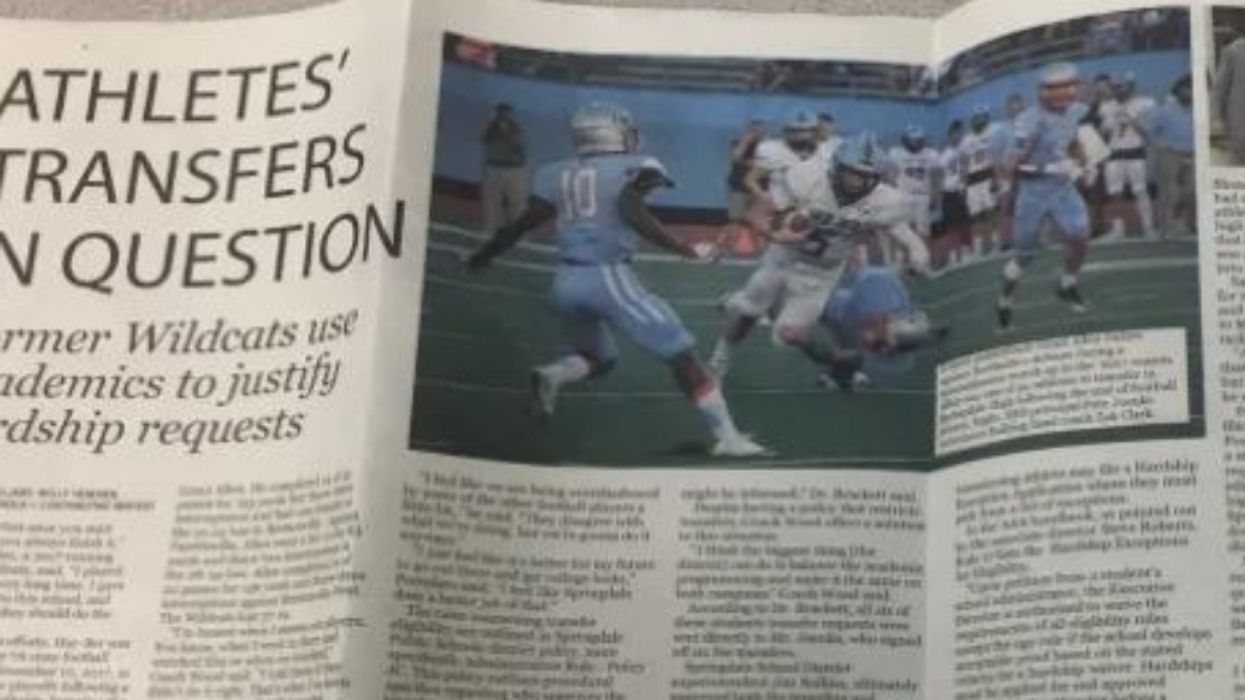November, 1999, LOS ANGELES - Thanks to "Star Trek," a show with its sight set steadfastly on the future, I have come to appreciate the richness and the complexity of the past. Recently I did two Star Trek events that literally transported me into a deeper appreciation of the vast history of human civilization. One was a Star Trek cruise from Los Angeles down the coast of Mexico, sailing through the Panama Canal and across the Caribbean to Fort Lauderdale, Florida. The other was a gigantic Star Trek convention in Berlin, Germany.
A cruise may not immediately seem like a journey into times gone by. It's fun, feasting and frolicking as one sails to exotic ports. And a Star Trek cruise is indeed all that. But this one, arranged by Cruise Trek of Agoura Hills, California, was also like a time machine that took me to three different centuries in our past.
One of our ports of call was a sleepy Guatemalan harbor called Puerto Quetzal. A 90-minute jet plane ride away, hidden deep in the dense jungle growth of centuries, is the ruins of the great Mayan civilization of Tikal. I wanted to visit it. But when we boarded our ship, the S.S. Veendam, in Los Angeles, we discovered that this off-ship tour was sold out! It was such a popular tour that the eager beavers had faxed in their reservation requests early and completely bought up all available seats on the jet to the jungle airport. At the welcome reception on board, actor Cecily Adams made an impassioned plea for more people to request the tour so that another plane might be chartered. I was already on the waiting list.
Happily, there were many others who wanted to view the ruins of Tikal and we got the required number to hire another plane. But this one was not a jet. To be charitable, it was a plane that amply qualified to be in a Guatemalan antique museum. But we aren't in Puerto Quetzal every other weekend and if this was our only way to get to Tikal, so be it. We wanted to experience the great Mayan ruins.
We boarded the old plane, our desire to go to Tikal greater than our confidence in the aged aircraft to get us there. As we climbed to cruising altitude, we wondered if there might be an omen in the music that wafted softly from the sound system. It was the theme from "Titanic." After a two-hour test of our nerves, we landed at the jungle airport a bit frazzled but intact and grateful.
Tikal blew away all apprehensions over that flight. It was astounding. Built some 2,500 years ago, central Tikal covers about 6 miles. We were told that there are over 3,000 structures --- temples, palaces, shrines, plazas both large and small, terraces, residences and ball courts all surrounded by a network of causeways. With our limited time, we would be able to see only the highlights.
Looming up out of the tangle of dense jungle growth, awe inspiring in its majesty, stood the ruins of four temple structures. Their bases were not pyramids but steeply slanted stepped shafts that soared up to a terrace in the sky. Imposingly ensconced on top were the ornately carved stone temples of the Mayan high priests. Climbing to the top was, literally, a breath-taking work out. Many in our group didn't even attempt it. Cecily Adams, fit athlete that she is, made it to the top. The view from that spectacular vantage was as breathtaking as the climb. Below was the great central plaza where the ritual ceremonies were held. Across the way were the other temple structures. And surrounding us all was the jungle that had claimed these awesome edifices when the Mayan nation mysteriously vanished long before the coming of the conquistadores. It boggled the mind to realize that this amazing civilization was built without the use of the wheel.
 A delicious native lunch was prepared for us at a jungle compound. We could have roamed among the ruins for the rest of the day. But our guide rushed us on. We had to return to the plane, he told us, so that we could take off by three o'clock in order to land at the Puerto Quetzal landing strip while there still was daylight. The reason for the urgency being that the Puerto Quetzal airstrip had no lights for night landings.
A delicious native lunch was prepared for us at a jungle compound. We could have roamed among the ruins for the rest of the day. But our guide rushed us on. We had to return to the plane, he told us, so that we could take off by three o'clock in order to land at the Puerto Quetzal landing strip while there still was daylight. The reason for the urgency being that the Puerto Quetzal airstrip had no lights for night landings.
We arrived back at the plane with time to spare. But once we were strapped into our seats, the pilot and co-pilot began inspecting the bottom of the ancient instrument panel with flashlights. Then a parade of people in sweat-stained work clothes began shambling up to the cockpit. They peered and tinkered and whispered cryptically among themselves. After a tense half-hour sitting in the tropical heat of an unventilated old plane, we were asked to return to the terminal building. I've never liked the word "terminal" associated with anything to do with flying, but now it was more unnerving than ever.
Riddled with apprehension, we filed back. Some headed straight for the bar and some good Guatemalan beer. Cecily, I discovered, is a woman with a remarkably low threshold of hysteria. She immediately placed a long distance call to her husband Jim back in Los Angeles and began a tear choked "I've always loved you and always will - forever and ever -- " farewell call. I felt more for the poor, hapless man than for Cecily.
Another suspenseful half hour later, a sweaty man came out to tell us that our plane cannot fly but that three small replacement planes were flying out from Guatemala City to take us back to Puerto Quetzal. If Cecily had an ounce of control left, that announcement blew it away. With panic flashing in her eyes, she began pounding on the glass wall of the waiting room. The terminal manager came out and rushed her into his office where she remained for the rest of our tension filled wait. The rest of us merely sat on pins and needles and waited. We had already lost more than an hour of precious daylight. The beer flowed freely as the Guatemalan sun slowly sank toward the jungle tree line.
It was twilight when the first plane arrived. Immediately, a semblance of a queue formed at the door. Through the plate glass window, we saw Cecily being hustled on board the first plane. The door was opened and people began to be let through, slowly and not too methodically, one after the other. Just three people before me, the first plane reached capacity. I didn't make it on to that plane. In a sense, I was kind of glad. When the passengers of one plane get divided up into three small planes, the risks are tripled. And I had an uneasy premonition about the one carrying Cecily.
The second plane landed just as the first was taxiing away. It was old and smaller but it didn't look as decrepit as the big one that brought us here. We boarded quickly and strapped ourselves in as rapidly as we could. But it was already dark as we began our taxi down the primitive runway. Everyone sat silently. But in the tense stillness, I sensed the one question screaming in everyone's mind. How is this plane going to land on an airstrip that has no lights?
The plane strained and heaved trying to lift itself off the runway. It coughed and gasped. I pulled up on my armrest hoping it would help. Just as the plane reached the end of the cracked concrete strip, it lifted off. It continued pulling and flexing, strenuously trying to avoid the treetops. It shuddered, recovered, then trembled wildly. Finally and thankfully, it reached its allowed flying altitude. The plane continued trembling as it droned into the darkened night sky.
Among the many activities on the cruise ship, I had been taking the yoga exercise class. The idea was to achieve inner peace by bringing one's mind and body into harmony with one's environment. If ever I needed peace and harmony with my surrounding, now was it. I closed my eyes and slowly began breathing in and out. I relaxed my mind and tried to become one with the droning, shivering world surrounding me. All of a sudden, that world turned electric white! Everything became a blinding, shocking, blazing whiteness. Was this it? Is this the way it happens? Was this the end? I was petrified. Then just as shockingly, everything turned back to as it had been. I saw the dark outlines of the passengers' heads ahead of me. The heads turned to each other in startled puzzlement. I realized then, that we had just experienced a silent lightening. Suddenly, it happened again. Another flash. An instantaneous splash of blue-white electricity that was gone as quickly as it came. We were flying through a tropical-lightening storm. A few more silent flashes and we were again flying through the ominously unchanging black sky.
After about an hour, I noticed a sprinkle of lights down in the blackness of the landscape below. Then, I noticed a river of moving lights snaking in the darkness. It looked like a road with automobiles. That must be Guatemala City, I thought. It was supposed to be the biggest city in the country and the capital. But it looked merely like a few dots and a squiggle of light. A few moments later, the landscape returned to black again.
The tension began to intensify as we sensed the plane beginning the descent into the darkness below. How is the pilot going to manage the landing without any lights to guide him? Our imaginations went wild as we girded ourselves for a rough landing. Our breaths held tight as the plane descended lower and lower. It was all blackness below. Then, far off in the distance, we saw something mystifying. We could make out what looked like a double row of lights. What was this? We were told that Puerto Quetzal had no landing lights. As we descended lower, we could surely see two distinct rows of lights beckoning us in the dark. Our pilot headed straight for it. Thank god, they had lights after all, we thought. It wasn't until we were almost about to touch down that we noticed that the lights were, in fact, a row of flickering flames. Standing next to the flaming lights, we saw the silhouettes of men carrying arms. With a hard, bone snapping bump, we touched down. We bounced and jounced down a potholed landing strip between the rows of flaming pots. When we finally came to a stop, we saw that the last part of the row of lights was made up of a line up of trucks and jeeps all parked with their headlights on. The Guatemalan authorities had risen to the challenge in a most creative way. They had improvised a primitive landing system by marshalling the Guatemalan armed forces to light fires in coconut shells lined up in a row together with the headlights of military vehicles. Necessity combined with human ingenuity had brought us back to earth, drained and weary but safe.
And dear Cecily. When we got back to the ship, we learned that the first thing she did when she got back on board was to place an international call to her anxiety-riddled husband back in Los Angeles. Their devotion to each other is genuinely touching. Such a contrast to the frazzled woman seated in front of me on the bus back to the ship. "When I get back to our cabin onboard," she groused, "my husband better not be asleep."
It was a nightmare trip back. But Tikal was worth it. In fact, the flight back seemed to underscore what we had seen at Tikal. The same original thinking and resourcefulness that produced the flaming night landing lights, had raised those amazing architectural splendors of Tikal without the use of the wheel. The power of human creativity and inventiveness is the one constant that defines civilizations through the ages. We would soon be experiencing another example of that from another age and another people --Americans with the Panama Canal.
The French tried for twenty years and failed to build a canal across the Isthmus of Panama connecting the Caribbean with the Pacific. Despite their success with the Suez Canal in Egypt, they could not overcome two great adversaries in Panama -- a devastating tropical disease and an awesome mountain range. The disease decimated whole armies of their workers and the earth from the towering mountainside kept caving down into their excavation.
With characteristic bravado, United States President Teddy Roosevelt took over when the French finally gave up. The first task for the Americans was to overcome the killer disease, which they found to be malaria. When they discovered that the carrier was mosquitoes, a massive eradication program was launched. All bodies of water were either drained or disinfected. Then a new, sanitary village was built to house the workers.
The great challenge then became to conquer the formidable barrier mountain range of the Continental Divide. The solution the engineers came up with was ingenious. Rather than digging a cut into the daunting obstacle, their idea instead was to create a lake rising above the mountain range, then lifting the ships up and over the mountain. The solution was as brilliant as the engineering job would be formidable. First, a lake in the sky had to be constructed. Then, a series of locks had to be built to raise the ships up to the man-made lake. Then another set of locks on the opposite side would lower the ships back down to sea level. It was a mind-boggling project. But the Americans did it. The Panama Canal took ten grueling years to build but in August of 1914, the first ship made the virgin crossing. Since then, over 800,000 ships have gone through the waterway. Our passage in October of 1999 was to be one of the last transits under American administration. At midnight, December 31, 1999, the canal is to be handed over to the Panamanian government. President Jimmy Carter, who signed the treaty in 1977, will represent the U.S. at the ceremony. There was a sense of history for all of us on board the S.S. Veendam as we sailed toward our crossing.
We got up bright and early in the morning and crowded onto the decks and other good vantage points. I found a comfortable seat by a panoramic picture window in the Crow's Nest, the topmost cocktail lounge in the ship. In the pale light of dawn, I could see the metropolitan skyline of Panama City in the distant northeastern horizon. We were munching on a breakfast of Panama rolls and coffee by the time we sailed under the massive steel girders of the Bridge of the Americas guarding the entrance to the canal.
Promptly at 7:30 a.m., we entered the first of a series of locks, this one called Miraflore Locks. The water came churning in with massive force as the ship slowly rose up. I marveled at the colossal power of water. Forty-five minutes later, we were sailing out and onto the first of the stepped lakes, Miraflore Lake. Soon we entered the next series of locks, the Pedro Miguel Locks. These locks raised our vessel up to the top level of the system and a great waterway called the Gaillard Cut. This was the part that was the greatest challenge to the builders of the canal - the cut through the rugged mountain range of the Continental Divide. About 8 miles long, it was carved through rock and shale. It was here that the principal excavation was required and here that those devastating slides occurred during construction.
I stepped outside to the deck and gazed out at the semi jungle landscape on each side of the great waterway. The dense tropical air instantly wrapped around me in a sultry embrace. It was awe inspiring to imagine men just a century ago, struggling against this brutal heat, disease and the savagery of the jungle to carve out this massive system of waterways. I marveled at the sheer ingenuity of the engineers. The Panama Canal is a triumph of human will, creativity and determination. It is as incredible an achievement as that of the Mayans centuries ago.
It was lunchtime when we sailed out onto the huge man-made body of water, Gatun Lake, and I was hungry. We had a few hours to go before we would be entering the downhill set of locks. I decided to go down for lunch. The view of the lake from the air-conditioned comfort of the ship's dining room was superb. As I dined on an exquisite lunch of poached sole with baby asparagus, I couldn't help but appreciate the almost surreal world that we inhabited. Certainly, it would have been science fiction to those who had struggled so valiantly to make this fantastical existence so comfortably real for us. Ah, the wondrous rewards of man's ingenuity.
Promptly at 2 p.m., we entered the Gatun Locks, the system lowering our ship down to sea level on the Caribbean side. By sunset, we were again out on the high seas. Our historic 9-hour transit across the Panama Canal was over. On our way back to Ft. Lauderdale, we enjoyed an all-too-brief stop at the charmingly preserved colonial city, Cartagena in Colombia. Like a dream, our two-week floating Star Trek convention was over. But the rich lessons from the past, experienced on this ocean trek, will remain with me for a long time.
Two days after returning from the cruise, I flew off to another Star Trek event -- this one, a land based convention. It, too, was a rich experience in a city dense with history -- the former, and once again, capital of Germany -- Berlin.
The convention, "Galileo 7-III," was gigantic. Over 2,500 fans gathered from throughout Europe and even a few from the U.S. Berlin was the place to be for Star Trek fans that weekend. The huge attendance, however, seemed to overwhelm the management of the convention. There were program delays, interminable lines and confusion. Yet, bless their hearts, the fans' enthusiasm remained unabated. The applause at each program event was thunderous. They reveled in the joy of sharing a weekend with kindred souls. And the convention raised 30 thousand German marks for charity as well.
But what truly impressed me was the city of Berlin itself. Here was a city, mindful of its history, vigorously building a future of unity. At a point in time when Europe is struggling to join eleven nations in an economic union, and when Germany is heroically working to bring together its two parts brutally separated for decades by a political wall, Berlin was building a world city. To accomplish this, the city had gathered some of the best architects from throughout the world. There were dazzling buildings designed by architects from the United States, Italy, Japan, Holland and, of course, Germany. Berlin was the shining symbol of a people confidant of their destiny and building for the next millenium. I sensed it in the spirit of the people. I felt it in the dynamism of the city. I saw it in the architecture of the new buildings.
The most intriguing building was the Jewish Museum by American architect David Leibeskind. The museum was to open in 2000 but I was privileged to tour the completed but empty building. The shape of the zinc-clad, zigzag structure could be seen as a bolt of lightning, a deconstructed Star of David or a sharp, metallic prison. The windows cut into this structure look like slashes, shards or fragments of shattered glass -- jagged reminders from history. The building is entered from an underground tunnel. The sense one gets on entering the slate paved entrance corridor is one of chilly disorientation. The walls are canted. The floor slightly ramped. Other corridors intersect at sharp angles. Nothing is parallel and regular. There are unexpected spatial voids suggesting the absence of a part of the community that once made up the people of Berlin. The design is at once sobering and stunning. But I couldn't help wondering how the building would work as an exhibition space for a museum. How do you hang things on these canted walls? How do you arrange artifact display cases in these oddly formed galleries? How do you keep the architecture from upstaging the exhibits themselves? My questions on the practicality, however, were overwhelmed by my awe of the virtuosity of the architect. The building alone makes the most unforgettable statement on the history of the Jewish people in Berlin. The new Jewish Museum is an eloquent architectural sculpture.
The most exhilarating new symbol in Berlin, for me, is the restored German parliament building, the Reichstag. The architect is Sir Norman Foster. His British citizenship is as symbolic, it seems to me, as his architectural brilliance is world renown. He took the bold, stony Baroque edifice of the Reichstag with all its turbulent history and sensitively restored the shell. In it, he designed a starkly contemporary legislative chamber and offices. The reminder of the past containing the vigor of a modern nation. His most inspired piece of the design however, is the glass dome that he placed right over the legislative chamber. The transparency of government could not have been more clearly communicated. Even more significantly, he designed a bank of elevators that whisk the public - with no admission charge - up to the roof of the building. The view of Berlin from this rooftop terrace is spectacular. From this terrace, Foster designed a spiral ramp in the dome allowing the people to traverse up to the top of the glass structure. From there, the people, not only of Germany but of the world, can look down directly on the lawmakers at work in the legislative chamber below. It is a potent statement about a people's democracy. As I was walking away from this inspiring building, I looked back again to get another perspective on it. Even from a distance, the Reichstag was alive with movement. There was the constant motion of people going up and down on the ramp in the glass dome over the heads of the politicians. What a powerful symbol for the future of democracy.
The gift of Star Trek's incredible popularity has provided me with these undreamed of opportunities to know this world. These experiences have given me a keen appreciation of the inseparable link between our past and our future. The barbarism of man's inhumanity to man reminds us of our terrible fallibility. The extraordinary achievements of our antecedents, their determination against sometimes awesome adversity, their great organizational competence and their creative genius inspires us to face the many challenges that we confront today. The solid launching pad of our future is the confidence we gain from the glorious attainments from history.
Kenan Thompson Just Hit The Ice With Other 'Mighty Ducks' Cast Members, And The Nostalgia Is Real Y'all 😍
A mini-reunion took place over the weekend, as actors from the Mighty Ducks film series met up at an ice rink in upstate New York. Afterwards, they attended an Anaheim Duck's game.
The nostalgia-fest started with Danny Tamberelli, who played Tommy Duncan in the first film, posting photos of the group to his Instagram.
They wore recreations of the bright green jerseys the team wore in the movie.
Watching them, you can almost hear the whine of your old VHS player.
@EW Luv this— christy hale (@christy hale) 1548122543.0
@EW https://t.co/qsDIs6qCFA— Edward Sanchez (@Edward Sanchez) 1548121751.0
There was a Mighty Ducks reunion at an NHL hockey game yesterday. Question of the day: Who watched the Mighty Duc… https://t.co/E2XfitCRBO— Ty Andrew Darbonne (@Ty Andrew Darbonne) 1548162147.0
I want to watch all the Mighty Ducks movies again after seeing the mini-reunion photos. https://t.co/R7YmvBhoXG— Sam (@Sam) 1548147775.0
He was joined by Kenan Thompson, Vincent LaRusso, Colombe Jacobsen-Derstine, and Garette Ratliff Henson. All five acted in at least one of the Mighty Ducks movies.
After the fun of skating around the ice rink, the group switched jerseys to the more modern Anaheim Ducks design. They wore personalized jerseys with the names of their characters on the back.
The Anaheim Ducks account posted about it on Twitter.
Some mighty great people joined us at today’s game! Some of your favorite Mighty Ducks visited us on Long Island a… https://t.co/k9g8iyWMAr— Anaheim Ducks (@Anaheim Ducks) 1548032893.0
People were tagging their friends to let them know!
@LissaBriana @movieweb Omg that’s awesome— Brittany S. (@Brittany S.) 1548112054.0
@kevinlembke @movieweb Lol yeah I saw. Ducks got shut out tho lmao— space oddity (@space oddity) 1548109701.0
The group got to watch a game the actual sports team started because of the popularity of their movie, played on Sunday against the New York Islanders.
The original film starred Emilio Estevez as Gordon Bombay, a lawyer charged with drunk driving, who has to perform 500 hours of community service. Because of his background as a child hockey star, Bombay is ordered to coach a peewee hockey team. While initially reluctant, he guides the misfits to victory.
Danny Tamberelli, Garette Ratliff Henson, and Vincent LaRusso starred in the first film, while Kenan Thompson and Colombe Jaconsen-Derstine were in the second.
It's unknown at this time why the group reunited, though some are speculating for a Superbowl commercial.
But we have to ask the real questions here.
Best sports movie reunion? RT for The Sandlot Like for Mighty Ducks https://t.co/QSsGmJcpkG— Adam Navarrete (@Adam Navarrete) 1548109324.0
And yes, obviously Estevez would return as an older drunker Gordon Bombay who now sharpens skates like my boy Hans— Scott Sweeney (@Scott Sweeney) 1548103145.0
The Kids From 'Stranger Things' Wrapped Presents For Superfans—And Did A Delightfully Terrible Job 😂
When it comes to giving gifts, not all celebrities are as crafty as Taylor Swift, but that didn't stop the adorable stars of Netflix's Stranger Things from giving it a try.
In a recently released video from Netflix, actors Millie, Finn, Noah, Caleb, Gaten, and Sadie got together for some holiday cheer and to wrap gifts for fans. But kids will be kids, even if they star in a hit television show. Watch as chaos ensues.
Fans loved every moment, even if the kids weren't the greatest wrappers.
@Stranger_Things I love seeing them mess around with each other.— Abby! (@Abby!) 1545318707.0
@doublejoywilson https://t.co/qgFgkZpTxQ— Stranger Things (@Stranger Things) 1545318849.0
@realrevella https://t.co/G5Er8pydg5— Stranger Things (@Stranger Things) 1545318801.0
@themallratss we do what we can https://t.co/POBMVbXfZS— Stranger Things (@Stranger Things) 1545319099.0
@Stranger_Things They’re a cute mess 😂— Janet ⁷✜🪐 (@Janet ⁷✜🪐) 1545318854.0
@minseokjin94 https://t.co/Dr4Y4xFYyM— Stranger Things (@Stranger Things) 1545318939.0
@Stranger_Things Thanks for the gif...they’re a MESS mess https://t.co/cG5ODdPDf0— Janet ⁷✜🪐 (@Janet ⁷✜🪐) 1545319571.0
@pvladins AH THE SOUND OF HOLIDAY CHEER— Stranger Things (@Stranger Things) 1545318737.0
@Stranger_Things HAPPY HOLYDAYS TO THE DEMOGORGON https://t.co/BpB1ZixUK5— 𝑣𝑎𝑙 ⚯͛ (@𝑣𝑎𝑙 ⚯͛) 1545318680.0
@edwardistheman @netflix ok here https://t.co/UwOLIa1T1C— Stranger Things (@Stranger Things) 1545318880.0
We just can't get enough of these talented kids!
Macaulay Culkin Is Having Fans Vote On What He Should Legally Change His Name To—And The Options Are Bizarre 😮
Have you ever wanted to help your favorite celebrity reach their potential by giving them a new name? Fans of Macaulay Culkin will be able to do just that, as he's allowing them to vote and pick his new middle name.
The choices are beyond strange.
Thanks for having me @jimmyfallon @FallonTonight !!! I'll let you know how the name change works out! https://t.co/iIkTC8OyXH— Macaulay Culkin (@Macaulay Culkin) 1543452222.0
In a segment on The Tonight Show with Jimmy Fallon, Culkin announced his desire to change his middle name to something else. He allowed people to submit names for the last month, and narrowed those down to the top five.
Some of the suggestions were interesting, to say the least.
@DevonESawa Weird. I'm about to change my middle name. Any good suggestion? Go to https://t.co/BYXGIWJK3g— Macaulay Culkin (@Macaulay Culkin) 1540529059.0
@IncredibleCulk @FallonTonight @jimmyfallon It should be "Culkin, Macaulay" as a middle name. Will be read as: Mac… https://t.co/xRo5AiR8jd— carmineenimrac (@carmineenimrac) 1543469371.0
@IncredibleCulk @jimmyfallon @FallonTonight How did you miss "Macaulay Skulking Culkin"?!— Caleb DAVIS (@Caleb DAVIS) 1543487990.0
@ComicBook @IncredibleCulk Pls add Cacaulay Mulkin as an option— Matt Michler 🌹 (@Matt Michler 🌹) 1543603411.0
@ComicBook @IncredibleCulk Kevin! Obviously.— Andrew 🐼 🐝 (@Andrew 🐼 🐝) 1543603516.0
The official choices: Shark Week, The McRib Is Back, Kieran (submitted by his famous younger brother), Macaulay Culkin, and Publicity Stunt. That last one was suggested by Culkin's girlfriend, actress Brenda Song, and gives away the game.
Fans are still excited to vote for his new name.
@IncredibleCulk @jimmyfallon @FallonTonight Macaulay “Shark Week” Culkin has a nice ring to it.🐰 Vote on… https://t.co/AS5ce275jl— Shark Week (@Shark Week) 1543526453.0
The moment of joy that hopefully comes to us all during the day just transpired for me and funny enough, it took le… https://t.co/stOVPePmpy— Sia Brooks (@Sia Brooks) 1543606608.0
Macaulay Culkin Needs A New Middle Name https://t.co/HO9ZMUM1O1 via @bunnyearsweb @IncredibleCulk I voted for "Kier… https://t.co/jnVAa6NTlp— Stetson (@Stetson) 1543815411.0
I voted for @IncredibleCulk new middle name, what did you do today?— Catalina F 🇨🇱 (@Catalina F 🇨🇱) 1543801274.0
@IncredibleCulk @jimmyfallon @FallonTonight I like Keiran— Melissa (@Melissa) 1543517677.0
McAuley Culkin is allowing fans to vote on what is legal middle name should be, two of the final 5 is “Macauley Cul… https://t.co/KUPTU0HnKR— YOUAREDEAD (@YOUAREDEAD) 1543620499.0
@IncredibleCulk @jimmyfallon @FallonTonight Just for you to know, I voted Macaulay Culkin!— 🍀 Maria (@🍀 Maria) 1543495868.0
This is all a publicity stunt to drive traffic to Culkin's website, Bunny Ears, launched earlier this year in March. The site bills itself as a lifestyle and holistic health brand, similar to Gwyneth Paltrow's Goop. However, the articles are jokes or satirical.
Good luck finding the site if you tried to go there right after the Fallon segment.
@IncredibleCulk @jimmyfallon Look at the bunny ears website now after @jimmyfallon voted on @IncredibleCulk middle… https://t.co/PFAwxsRB8E— Charles John Kelly (@Charles John Kelly) 1543485190.0
With articles like "A Tour Guide Of The Places Where Men Have Dumped Me" in their 'Travel Guides' section, or "Meditative Things White People Can Do While Black People Attempt To Explain White Privilege" under 'Spiritual Wellness,' it's difficult to imagine the site is wanting for traffic.
Time will tell what Culkin's new middle name will be, but as of this writing, it's looking like he'll be known as Macaulay Macaulay Culkin Culkin. Which is a shame, because Macaulay Shark Week Culkin had such a nice ring to it.
H/T: Huffington Post, Bunny Ears
Arkansas High School Suspends Student Paper For Publishing 'Disruptive' Investigation Into Shady Football Transfers
Halle Roberts is the editor-in-chief of the Har-Ber Herald, the school newspaper for Springdale High School in Arkansas. The 17-year-old student was suspended after she wrote an investigative piece criticizing the transfer of five football players to a rival school.
Players are not allowed to be transferred to a different school because they would like to play for a different team. They are allowed to transfer only for academic reasons. So Roberts got to digging. Her paper filed FOIA requests and received official information from the Arkansas Activities Association saying that the students were transferred for academic reasons. However, the students themselves said otherwise.
Roberts quoted one student in her paper saying:
"We just want to go over there because we have a better chance of getting scholarships and playing at D1."
Another student told Roberts:
"I just feel like it's better for my future to go out there and get college looks."
Soon after the report was published, the superintendent of the district, Jim Rollins, asked the teacher advisor for the school paper, Karla Sprague, to take the story down. She obliged.
Rollins wrote a letter stating that the piece was:
"intentionally negative, demeaning, derogatory, hurtful and potentially harmful to the students addressed in those articles."
Roberts, undeterred, is still working on a new edition of the story that includes the school's censorship.
Mike Hiestand of the Student Press Law Center had this to say:
"School officials at this point seem to me to have completely thrown up their hands and said, ‘we’re not going to l… https://t.co/PgVYFlVAlM— Amber Jamieson (@Amber Jamieson) 1543687827.0
And Halle Roberts, who dreams of being an ESPN reporter, stated:
“They are like ‘well you raised an uproar, we’re going to try and silence you,’” said Halle Roberts, 17, the editor… https://t.co/6dKFeF0so4— Amber Jamieson (@Amber Jamieson) 1543690272.0
People were impressed with Roberts.
@hallecole21 @BuzzFeedNews I'm so proud of you! You're not just fighting for yourself, you're fighting for student… https://t.co/hjVIvzstZ1— 🌺Lisa Daily is writing⛱ (@🌺Lisa Daily is writing⛱) 1543718652.0
@hallecole21 @BuzzFeedNews I shared your story on my Facebook page and am so proud of you kids for telling the stor… https://t.co/9gekpHSwey— Derryl Trujillo (@Derryl Trujillo) 1543694164.0
@hallecole21 @BuzzFeedNews Keep up the fight Halle!!— Katie Maner (@Katie Maner) 1543762811.0
Some had harsh words for the school's administration.
@BuzzFeedNews @KatinaParon The principal and the superintendent should be fired, not the teacher. And the students… https://t.co/AfE6JTmowp— Jody Beck (@Jody Beck) 1543754569.0
@ambiej @BuzzFeedNews Abuse of power by the school administration— Lovehersports50 (@Lovehersports50) 1543686742.0
@ambiej Hey @sdaleschools School board members. Why are you allowing Arkansas Har-Ber High School Principal Paul Gr… https://t.co/8pdT0St1FO— Nancy Levine (@Nancy Levine) 1543693785.0
And most had high praise for Roberts and the other student journalists working on this piece.
A great example of investigate student journalism, and why it needs more recognition. https://t.co/s4MBLn0HiN— Gabija Gataveckaitė (@Gabija Gataveckaitė) 1543692451.0
Much to appreciate about @ambiej’s reporting on this Arkansas school district’s effort to suppress a high school pa… https://t.co/fIk5vTaWCZ— Pat Berry (@Pat Berry) 1543688372.0
High school students do real journalism, school district immediately tries to shut them down, despite state law gua… https://t.co/HqOgXTv1bl— Jeff Amy (@Jeff Amy) 1543692270.0
Oh this is the good stuff. I love this editor. Great work. Stand for journalists. https://t.co/QlrTTzrqs8— Scott Lewis (@Scott Lewis) 1543693549.0
And Halle Roberts herself closed by saying:
thank you so much. #freedomofthepress https://t.co/LsjWT7nycD— halle roberts (@halle roberts) 1543685392.0
Fight on, Halle!
















